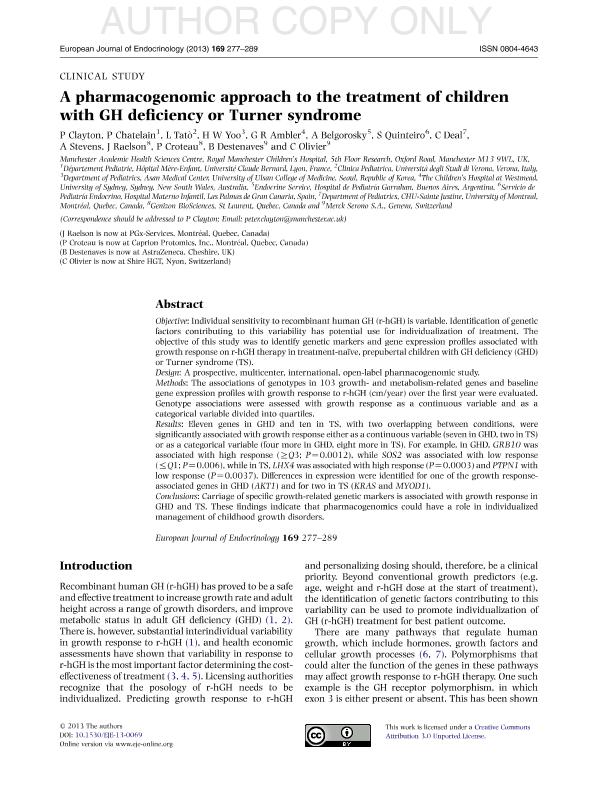Mostrar el registro sencillo del ítem
dc.contributor.author
Clayton, P.
dc.contributor.author
Chatelain, P.
dc.contributor.author
Tato, L.
dc.contributor.author
Yoo, H. W.
dc.contributor.author
Ambler, G. R.
dc.contributor.author
Belgorosky, Alicia

dc.contributor.author
Quinteiro, S.
dc.contributor.author
Deal, C.
dc.contributor.author
Stevens, A.
dc.contributor.author
Raelson, J.
dc.contributor.author
Croteau, P.
dc.contributor.author
Destenaves, B.
dc.contributor.author
Olivier, C.
dc.date.available
2016-01-20T20:43:07Z
dc.date.issued
2013-06-12
dc.identifier.citation
Clayton, P.; Chatelain, P.; Tato, L.; Yoo, H. W.; Ambler, G. R.; et al.; A pharmacogenomic approach to the treatment of children with GH deficiency or Turner syndrome; Bioscientifica; European Journal of Endocrinology; 169; 12-6-2013; 277-289
dc.identifier.issn
0804-4643
dc.identifier.uri
http://hdl.handle.net/11336/3723
dc.description.abstract
Objective: Individual sensitivity to recombinant human GH (r-hGH) is variable. Identification of genetic factors contributing to this variability has potential use for individualization of treatment. The objective of this study was to identify genetic markers and gene expression profiles associated with growth response on r-hGH therapy in treatment-naïve, prepubertal children with GH deficiency (GHD) or Turner syndrome (TS).
Design: A prospective, multicenter, international, open-label pharmacogenomic study.
Methods: The associations of genotypes in 103 growth- and metabolism-related genes and baseline gene expression profiles with growth response to r-hGH (cm/year) over the first year were evaluated. Genotype associations were assessed with growth response as a continuous variable and as a categorical variable divided into quartiles.
Results: Eleven genes in GHD and ten in TS, with two overlapping between conditions, were significantly associated with growth response either as a continuous variable (seven in GHD, two in TS) or as a categorical variable (four more in GHD, eight more in TS). For example, in GHD, GRB10 was associated with high response (≥Q3; P=0.0012), while SOS2 was associated with low response (≤Q1; P=0.006), while in TS, LHX4 was associated with high response (P=0.0003) and PTPN1 with low response (P=0.0037). Differences in expression were identified for one of the growth response-associated genes in GHD (AKT1) and for two in TS (KRAS and MYOD1).
Conclusions: Carriage of specific growth-related genetic markers is associated with growth response in GHD and TS. These findings indicate that pharmacogenomics could have a role in individualized management of childhood growth disorders.
dc.format
application/pdf
dc.language.iso
eng
dc.publisher
Bioscientifica

dc.rights
info:eu-repo/semantics/openAccess
dc.rights.uri
https://creativecommons.org/licenses/by/2.5/ar/
dc.subject
Ghr
dc.subject
Turner Syndrome
dc.subject
Gh Deficiency
dc.subject
Rhghsensitivity
dc.subject.classification
Genética y Herencia

dc.subject.classification
Ciencias Biológicas

dc.subject.classification
CIENCIAS NATURALES Y EXACTAS

dc.title
A pharmacogenomic approach to the treatment of children with GH deficiency or Turner syndrome
dc.type
info:eu-repo/semantics/article
dc.type
info:ar-repo/semantics/artículo
dc.type
info:eu-repo/semantics/publishedVersion
dc.date.updated
2016-03-30 10:35:44.97925-03
dc.journal.number
169
dc.journal.pagination
277-289
dc.journal.pais
Reino Unido

dc.journal.ciudad
Bristol
dc.description.fil
Fil: Clayton, P.. Royal Manchester Children’s Hospital. Manchester Academic Health Sciences Centre; Reino Unido
dc.description.fil
Fil: Chatelain, P.. Université Claude Bernard. Hopital Mère-Enfant. Département Pediatrie; Francia
dc.description.fil
Fil: Tato, L.. Università degli Studi di Verona. Clinica Pediatrica; Italia
dc.description.fil
Fil: Yoo, H. W.. University of Ulsan. College of Medicine. Asan Medical Center. Department of Pediatrics; Corea del Sur
dc.description.fil
Fil: Ambler, G. R.. University of Sydney. The Children’s Hospital at Westmead; Australia
dc.description.fil
Fil: Belgorosky, Alicia. Gobierno de la Ciudad de Buenos Aires. Hospital de Pediatría "Juan P. Garrahan"; Argentina. Consejo Nacional de Investigaciones Científicas y Técnicas; Argentina
dc.description.fil
Fil: Quinteiro, S.. Hospital Materno Infantil. Servicio de Pediatría Endocrino; España
dc.description.fil
Fil: Deal, C.. University of Montreal. Department of Pediatrics; Canadá
dc.description.fil
Fil: Stevens, A.. Royal Manchester Children’s Hospital. Manchester Academic Health Sciences Centre; Reino Unido
dc.description.fil
Fil: Raelson, J.. Genizon BioSciences; Canadá
dc.description.fil
Fil: Croteau, P.. Genizon BioSciences; Canadá
dc.description.fil
Fil: Destenaves, B.. Merck Serono S.A.; Suiza
dc.description.fil
Fil: Olivier, C.. Merck Serono S.A; Suiza
dc.journal.title
European Journal of Endocrinology

dc.relation.alternativeid
info:eu-repo/semantics/altIdentifier/url/http://www.eje-online.org/content/169/3/277.long
dc.relation.alternativeid
info:eu-repo/semantics/altIdentifier/url/http://www.ncbi.nlm.nih.gov/pmc/articles/PMC3731924/
dc.relation.alternativeid
info:eu-repo/semantics/altIdentifier/issn/0804-4643
dc.relation.alternativeid
info:eu-repo/semantics/altIdentifier/doi/http://dx.doi.org/10.1530%2FEJE-13-0069
Archivos asociados
